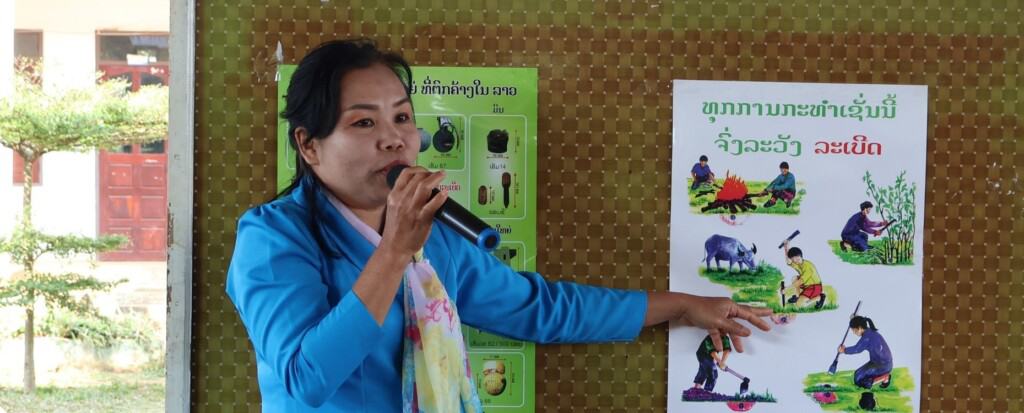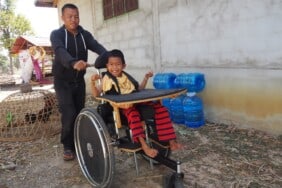This website uses cookies so that we can provide you with the best user experience possible. Cookie information is stored in your browser and performs functions such as recognizing you when you return to our website and helping our team to understand which sections of the website you find most interesting and useful.


Five-year-old Noi was playing in her yard on a cold morning. Her mother made a fire to keep warm. Without warning, an explosion sent metal fragments flying through the air. A small piece struck Noi, lodging itself in her right eye. The fire had set off an unexploded ordnance (UXO) that was buried deep under the ground.
Tens of millions of UXOs that were left behind from the Indochina War in Laos and Cambodia and internal conflict in Myanmar continue to cause injuries and deaths. Since the 1990s, we’ve worked to raise awareness of the dangers of UXO and provide support to survivors.
In 1996, we began partnering with the U.S. Department of State’s War Victims Medical Fund to help thousands of UXO survivors like Noi access specialized medical treatment by covering healthcare costs and associated expenses.
At the same time, we started delivering education programming on the risks of UXO to schools and communities to help prevent accidents. We developed a UXO awareness curriculum for primary schools and trained teachers through the national teacher training program on effective methods for teaching UXO injury prevention.
Those with injuries from UXO have high rates of poverty due to disabilities that prevent them from maintaining a sustainable income. Along with medical cost assistance, our programming provided financial literacy, vocational training and small business start-up support. UXO survivors and their families have received training in trades like animal husbandry, fish farming, weaving, and tailoring, and grants to purchase necessary equipment to begin earning income.
UXO survivors who completed technical training averaged a 30% profit and consistently reinvested their profits back into their businesses
For school-aged survivors, we provided support to enable children to return to school and arranged tutoring assistance and peer discussion groups to support their adjustment back into community life.

To improve UXO accident victims’ rate of survival and rehabilitation after an accident, we worked to improve Laos’ emergency and trauma care medical systems through training and the provision of equipment. We strengthened the capacity of medical trainers to train others in trauma care, developed a standardized National First Aid Curriculum for the training of Village Health Volunteers, and created a curriculum in Critical and Emergency Care Nursing at the University of Health Sciences.
To identify existing gaps in services for UXO survivors, we conducted a comprehensive needs assessment and created action plans based on the findings for 200 survivors and their families. In the Xieng Khouang province in Laos, we worked with partners to develop the first ever UXO survivor database to improve case management. In the Kayah State of Myanmar, we collected data on people with disabilities to understand who they are, where they lived, how disability impacted their lives, and what services they needed.
Along with our partners, we facilitated Victim Assistance and Disability Working Group meetings with the Department of Social Welfare to further conversations on improving services and promoting inclusion. We addressed the limited state-level coordination among groups involved in victim assistance and disability issues, strengthening service and referral networks, and increased the capacity of government staff and organizations to continue meeting needs.
Over the years, we’ve worked to meet needs of people with disabilities through rehabilitation and health services, psychosocial support, assistive products and home-based modifications to enhance independent living, and awareness raising on the importance of inclusion.

Though the occurrence of UXO incidents has lowered over these years, accidents continue to happen – and an average of 48% of all reported accident victims are children or youth. We continue to inform young people about how to protect themselves and their peers through school curriculum, teacher training, and community events like puppetry performances. In Laos, we will continue to promote safety messages by creating curriculum for non-formal education centers that will reach young people who have dropped out of formal education, as well as workers pursuing equivalency degree certificates. We will also partner with Village Education Development Committees to help spread safety messages within at-risk communities. With support from our Behavior Initiative, we’re developing social behavior change campaigns to promote safety through various channels, including social media and community loudspeakers.
We aim to see all UXO accidents eliminated, but until then, we are dedicated to raising awareness of UXO risk and supporting survivors’ medical care, mental health, economic situations, education, and societal inclusion. By equipping government and NGO partners to continue delivering explosive ordnance risk education, providing high quality accessible health care, and meeting the complex needs of survivors and people with disabilities, these programs will continue making an impact.

